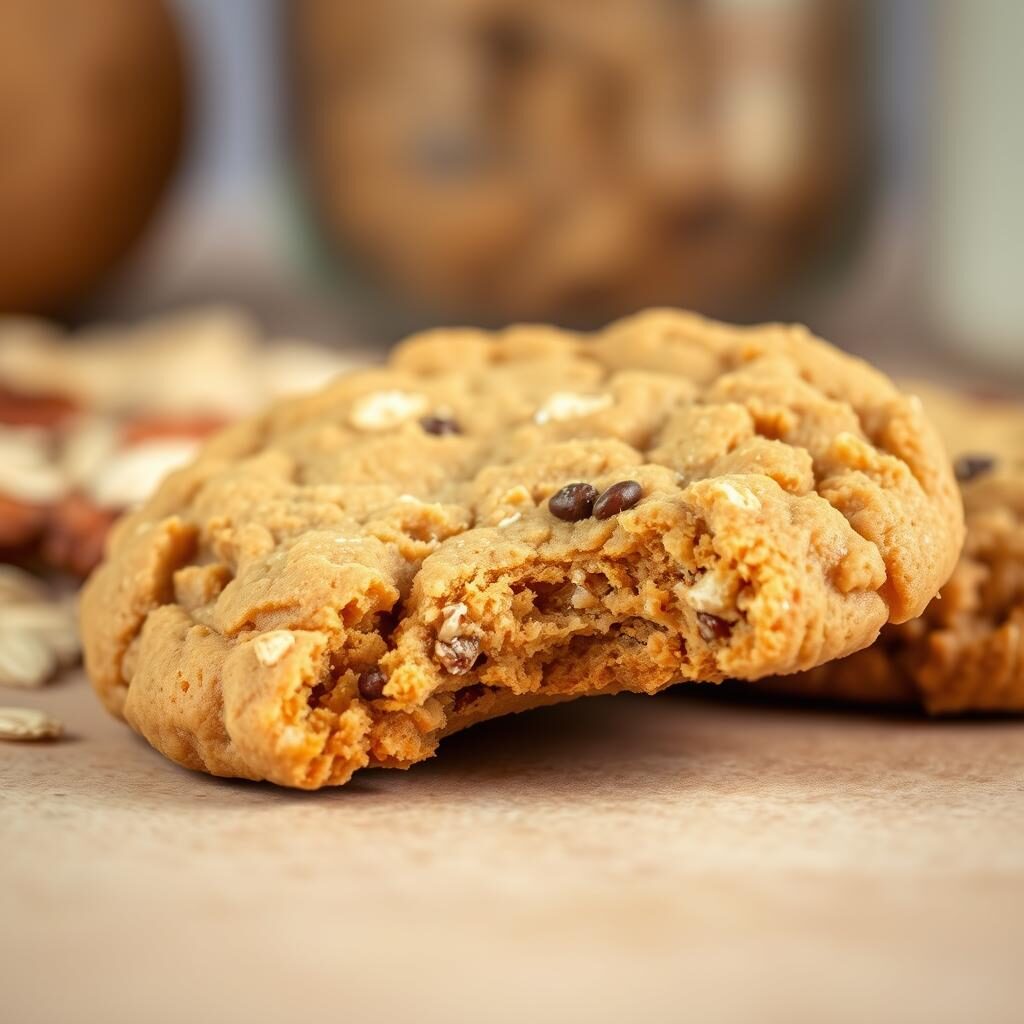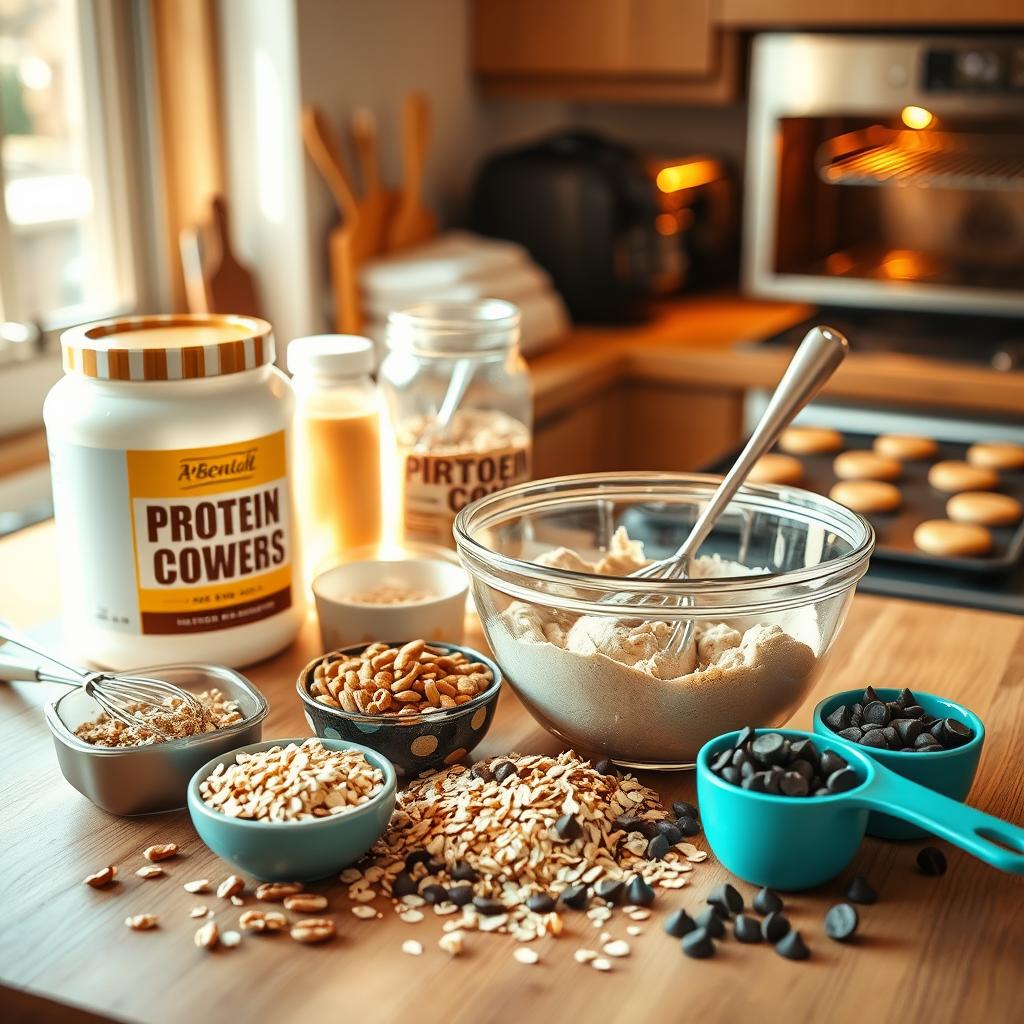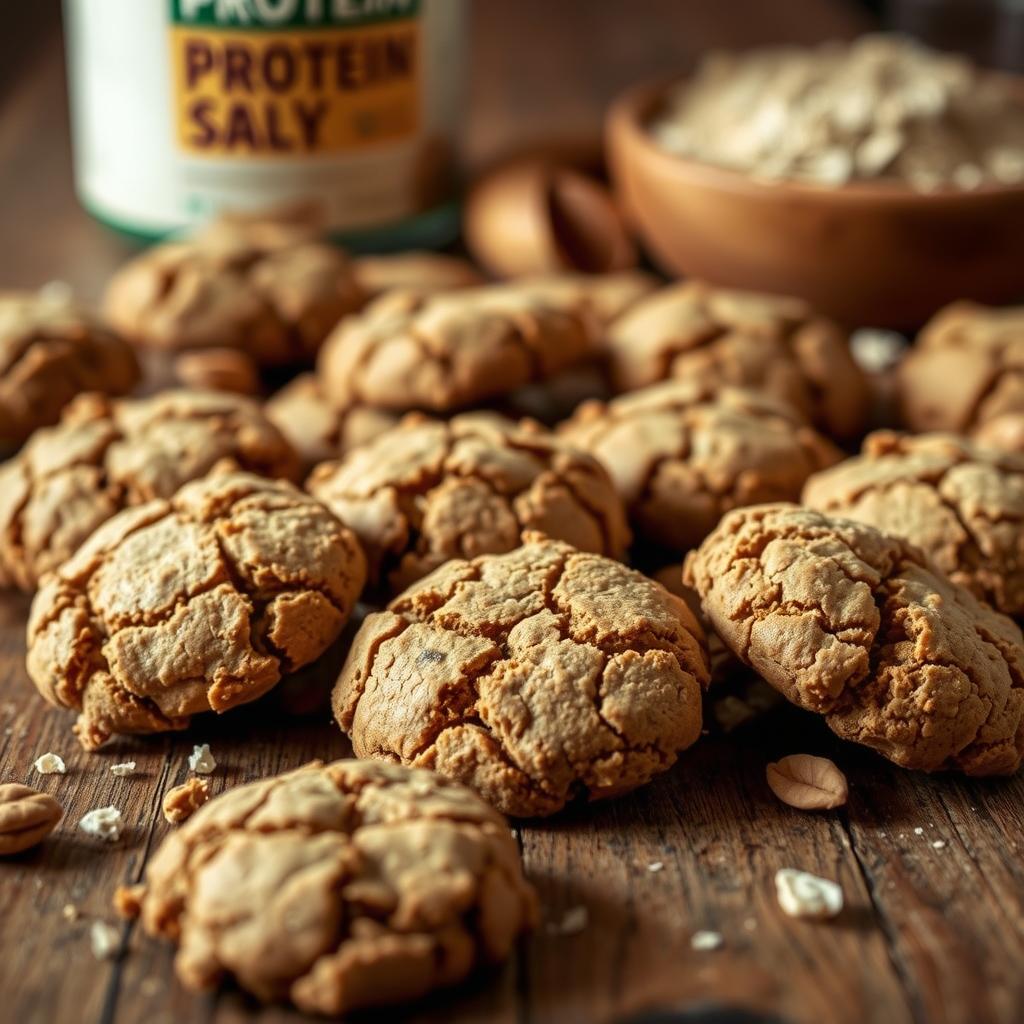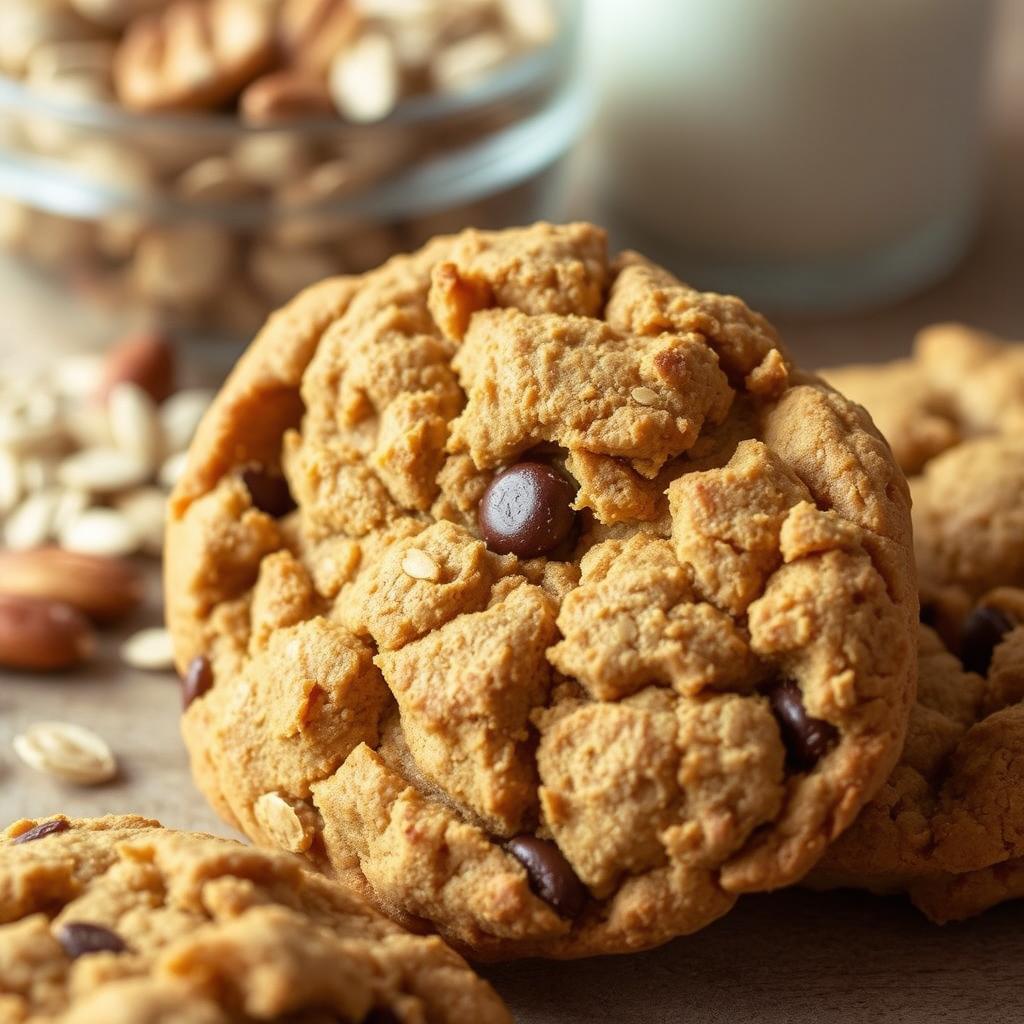Why are protein cookies so dry? Ever had a protein cookie that turned out dry and crumbly? I have, and it’s frustrating. The cause is simple: it’s all about the science of baking with protein powder.
Let’s explore how protein cookies are made, focusing on the role of protein and how it interacts with other ingredients. We’ll also examine why they can sometimes turn out dry and how to fix it. By learning this science, you can make moist and tasty protein cookies that you’ll love.

Key Takeaways
- Protein powder can make cookies dry and crumbly.
- How proteins mix with other ingredients like flour and fats is key to texture.
- The type and amount of protein used affects moisture and feel.
- Knowing the science of protein-rich baking helps get the right mix of protein, moisture, and texture.
- Using the right ingredients and baking techniques can improve your protein cookies’ moisture and quality.
Understanding the Basic Science Behind Protein Cookies
Baking science is key to making tasty and healthy protein cookies. It involves knowing how protein powder works and how ingredients mix. This knowledge helps you get the right texture and moisture.
The Role of Protein Powder in Baking
Protein powder is crucial in making protein cookies. It can be whey-based or plant-based. The type and amount affect the cookie’s taste and texture.
How Proteins Interact with Other Ingredients
Proteins in cookie dough interact with flour, fats, and sweeteners. This interaction is vital for the cookie’s softness and chewiness. It’s all about finding the right balance.
Moisture Absorption Properties of Protein
Protein’s moisture absorption can make cookies dry. Different proteins absorb water differently. This affects the cookie’s moisture and texture.
Learning about protein cookies’ science helps you make better treats. You’ll understand how protein works and improve your baking skills.

Why Are Protein Cookies So Dry?
Have you ever bitten into a protein cookie and found it dry? This dryness can be a big letdown. It makes the cookies less fun to eat. But why do protein cookies tend to be so dry?
The main reason for this dryness is the high amount of protein powders in the cookies. These powders, from whey or plants, change how the cookies feel. They make the cookies dry.
- Proteins don’t hold onto moisture like flour or sugar do. So, cookies with more protein dry out faster.
- Protein powders soak up more moisture than other dry ingredients. This means there’s less water for the other ingredients to mix with. This makes the cookies dry and crumbly.
- How proteins mix with fats and carbs also adds to the dry, dense feel of protein cookies.
Understanding why protein cookies are dry can help bakers and eaters. It’s not just about the science. It’s about making the perfect cookie.

| Ingredient | Contribution to Dryness |
|---|---|
| Protein Powder | High protein content, moisture-absorbing properties |
| Flour | Provides structure, but less moisture-retentive than other ingredients |
| Fats and Oils | Can help counteract dryness, but must be balanced with other ingredients |
| Sweeteners | Can compete with proteins for available moisture, affecting texture |
Knowing why protein cookies are dry helps bakers and eaters. It lets them choose better ingredients and baking methods. This way, they can make cookies that are just right.
The Impact of Different Protein Sources on Cookie Texture
Choosing the right protein source is key for protein cookies. Whey and plant-based proteins have different effects on texture. Knowing how they work with moisture is important for the perfect cookie.
Whey Protein vs. Plant-Based Proteins
Whey protein, from dairy, makes cookies chewy and structured. Plant-based proteins, like pea or soy, make cookies drier and crumblier. This is because plant proteins absorb more moisture.
How Protein Concentration Affects Moisture
Protein levels in cookies affect their texture. More protein means drier, denser cookies. Finding the right balance with fats and carbs is key for moisture and chewiness.
Understanding Protein-to-Flour Ratios
The protein-to-flour ratio is crucial for cookie texture. A higher ratio means drier cookies, while a lower ratio makes them softer. Trying different ratios can help you get the texture you want.
| Protein Source | Impact on Texture |
|---|---|
| Whey Protein | Chewy, structured texture |
| Plant-Based Proteins | Drier, more crumbly texture |
Understanding protein sources and their effects can improve your cookie recipes. This way, you can make the perfect texture that everyone loves.
Common Ingredients That Contribute to Dryness
When making protein cookies, some ingredients can make them dry and crumbly. Knowing which ones are the problem is the first step to making them moist and tasty. Check out dry baked goods for tips.
Protein powder is a big culprit. It’s great for nutrition, but too much can soak up moisture, making cookies dry. Try adjusting the protein-to-flour ratio to improve your cookies.
The type of flour you use also matters. Flours like whole-wheat and nut flours are nutritious but absorb a lot of moisture. Using a lighter flour can help keep your cookies moist.
| Ingredient | Impact on Moisture | Potential Substitutions |
|---|---|---|
| Protein Powder | High concentrations can dry out cookies | Adjust protein-to-flour ratio |
| Whole-Wheat Flour | More absorbent than all-purpose flour | Replace with a portion of all-purpose flour |
| Nut Flours | Highly absorbent, leading to dryness | Substitute with alternative flour sources |
Understanding how these ingredients affect moisture can help you make better protein cookies. Try different substitutions and ratios to find the perfect mix. This way, you’ll create cookies that are both moist and delicious.
The Science of Moisture Retention in Baked Goods
Knowing how moisture works in baking is key, especially for protein-rich cookies. The moisture in these cookies affects their texture, taste, and look. Let’s explore what keeps them moist and tasty.
Water Activity in Protein-Rich Baking
Water activity is a big deal in baking. It’s about the free water in food. In protein cookies, protein powder changes how water acts. Keeping the right water activity is vital for keeping cookies moist.
Understanding Hydration Levels
Hydration levels are also important. The water to dry ingredients ratio affects cookie texture and moisture. Finding the perfect balance between protein and water is tricky but crucial.
The Role of Fats and Oils
Fats and oils play a big role in keeping cookies moist. They act as a shield, stopping water from evaporating too fast. Choosing the right fats and oils can make your cookies tender and tasty.
By grasping the science of moisture content in protein cookies and baking science for protein cookies, you can make moist and delicious treats. These will surely please your taste buds.
How Baking Temperature and Time Affect Moisture Content
Getting the right moisture in protein-rich cookies is a delicate task. It involves balancing temperature and baking time. Knowing the science behind this is key to making protein cookie recipes better. This way, you can create soft, chewy treats every time.
Proteins in cookies tend to soak up moisture. When exposed to heat, they can dry out quickly. This leads to a crumbly texture that’s not what you want.
To avoid this, finding the right temperature and time is crucial. Using a lower oven temperature (around 325°F) and a longer baking time (12-15 minutes) helps. This slow cooking keeps the cookies moist. It prevents them from drying out too fast.
| Baking Temperature | Baking Time | Moisture Content |
|---|---|---|
| 325°F | 12-15 minutes | Optimal |
| 350°F | 8-10 minutes | Moderate |
| 375°F | 6-8 minutes | Minimal |
By understanding baking science for protein cookies, you can tweak your oven settings. This way, you can make improving protein cookie recipes that are moist and full of protein.
“The key to moist, delicious protein cookies lies in the perfect balance of baking time and temperature.”
Natural Ingredients That Improve Cookie Moisture
Natural ingredients can change the game for your protein cookies. They add moisture and texture. You can also make your cookies healthier and tastier.
Using Fruit-Based Ingredients
Fruits like applesauce, mashed bananas, or pureed pumpkin make your cookies sweeter and moister. They add fiber, vitamins, and antioxidants. Just remember to adjust the flour and sugar to get the right texture.
Healthy Fat Alternatives
Try using nut butters, avocado, or coconut oil instead of butter or oil. These fats keep your cookies moist and add nutrients. They also give a rich flavor.
Natural Binding Agents
Chia seeds, ground flaxseeds, or egg whites help your cookies hold together. They prevent crumbling and make the texture better. This makes your cookies more enjoyable to eat.
Using these natural ingredients can make your protein cookies better. They’re more moist and nutritious. Try different mixes to find the perfect taste for your fitness goals.
Technical Solutions for Better Protein Cookie Texture
Struggling to get the perfect texture in your protein cookies? Don’t worry! There are many technical solutions and advanced techniques to improve your cookies’ mouthfeel. By diving into the science of protein-rich baking, you can make your cookies soft, chewy, and delicious.
Adding texture enhancers is a great way to enhance your cookies’ texture. Ingredients like gums or starches help keep moisture in and prevent dryness. Also, trying different mixing methods, like creaming wet ingredients well or using a stand mixer, can lead to a better texture.
Want to improve protein cookie recipes? Mixing different proteins is a good idea. Combining whey protein with plant-based proteins like pea or almond flour can make your cookies more balanced and less likely to be dry.
“The key to achieving the perfect protein cookie texture is all about finding the right balance of ingredients and techniques.”
Using special equipment, like a convection oven or a cookie press, can also affect your cookies’ texture. Convection ovens bake evenly, preventing edges from drying out too fast. A cookie press helps make cookies the same shape and thickness, ensuring they cook evenly.
By trying these technical solutions in your baking, you’ll get closer to the perfect protein cookie texture. Remember, perfecting your recipe takes patience, experimentation, and understanding baking science.
Balancing Macronutrients for Optimal Texture
Creating tasty and healthy protein cookies means getting the macronutrients just right. The mix of protein, fat, and carbs affects how they taste and feel. This balance is key for making your snacks both delicious and nutritious.
Protein-to-Fat Ratio Guidelines
Experts say to aim for a 1:1 protein-to-fat ratio in protein-rich treats. If your recipe has 20 grams of protein powder, add about 20 grams of healthy fats. This could be nut butters, coconut oil, or avocado. It keeps the cookies soft and full of protein.
Carbohydrate Considerations
Carbs are also important for texture in high-protein cookies. Adding the right carbs, like oats or whole-wheat flour, adds moisture. Aim for carbs to make up 20-30% of the total macronutrients.
By focusing on the macronutrient ratios in protein baked goods, you can make high-protein snacks that are soft and chewy. Your customers will surely enjoy them.
Storage Tips to Maintain Freshness
Keeping protein cookies fresh is key to enjoying them. Whether baking at home or buying pre-made, the right storage is crucial. It helps keep the cookies moist and tasty.
Store your cookies in an airtight container or bag. This keeps moisture in and prevents drying. Don’t put them in the fridge, as it can dry them out. Instead, store them at room temperature in a cool, dark spot.
To keep cookies fresh longer, try adding a slice of bread to the container. The bread helps control humidity. It pulls moisture away from the cookies, keeping them soft.
| Storage Recommendation | Impact on Moisture Content |
|---|---|
| Airtight container or bag | Helps retain moisture |
| Room temperature storage | Avoids drying from refrigeration |
| Adding a slice of bread | Regulates humidity for softer cookies |
By following these tips, you can enjoy your protein cookies for days. A little care can prevent dryness. You’ll get the perfect mix of moisture content in protein cookies and protein.
Conclusion
In this article, we’ve looked into why protein cookies often turn out dry. We’ve talked about how protein powder affects baking and the differences between various protein sources. Now, you know what makes protein cookies dry and how to fix it.
Whether you use whey or plant-based proteins, you can make moist and tasty protein cookies. Adding fruits and healthy fats helps keep them moist. With a bit of tweaking and understanding, your protein cookies will be both healthy and delicious.
Understanding the science of baking protein cookies is crucial for health-conscious bakers. By using the tips from this article, you can make your protein cookies better. Soon, you’ll impress everyone with your protein-packed treats that are both healthy and enjoyable.


1 thought on “Why Are Protein Cookies So Dry? Learn The Science”